Chapter 1 – Insects and Humans on the Tree of Life
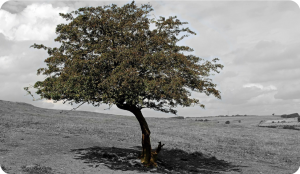
Approximately 600 million years have elapsed since humans and insects shared their last common evolutionary ancestor. However, as we will discover, the similarities between humans and insects are still quite striking, as are the differences that emerged between these two lineages over time. Therefore, before we begin comparing and contrasting the ways that humans and insects handle the same basic challenges, (i.e. acquiring and delivering oxygen to all of our cells, ingesting and digesting food, growing/developing, sensing and responding to the environment and producing offspring), it is worthwhile to define the characteristics that are unique to insects and humans as well as the closest relatives of these groups. Yes friends, this means that we will focus in this chapter on animal taxonomy and systematics.
Nearly all of you will have been taught the various taxonomic classifications at some point in high school biology classes (and likely have varying levels of hate or disgust for these topics). Rather than repeating this effort, what we will do here is to provide a quick and broad overview of the various characteristics that are unique to insects (and other arthropods) and humans (and other mammals), rather than go into any detail about specific groups. We will also limit our discussion of non- relevant taxa/groups to a bare minimum. When we do refer to these groups, we do so to highlight the diversity among animals generally, as well as what specifically distinguishes our groups of interest from other closely-related groups. Therefore, at the end of this chapter you should have a solid understanding of what characteristics insects share with other arthropods, and which characteristics are unique to them. Likewise, you should also be able to articulate how humans are similar to and different from other mammals and members of our own phylum Chordata, as well as insects and other invertebrates.
I. Taxonomy & Systematics
Taxonomy
Before we delve into the various taxonomic levels that help to place humans and insects on the tree of life, it is useful to review by what we actually mean by“taxonomy” and “systematics,” as well as their benefits and limitations. Taxonomy is the branch of science concerned with naming, describing, and classifying all living organisms. The system we use to classify organisms was developed by the Swedish plant biologist, Carl Linnaeus, in his book “Systema Naturae,” first published in 1735. In it, he classified organisms into various taxa or groups based on shared characteristics. The individual taxa are organized into several levels starting at the most general and becoming progressively more specific. This same general principle is used in the modern biological classification system wherein organisms are first placed into Domains or Kingdoms (the broadest taxonomic levels), and are then refined into smaller and smaller groups that share more and more similar characteristics. Figure 1.1 provides an illustration of the taxonomic levels and how they are used to classify the red fox.
Many of you have likely learned some sort of mnemonic device to remember the sequence of each taxonomic rank: Domain, Kingdom, Phylum, Class, Order, Family, Genus, and species. One common one is “Do kings play chess on Fridays, generally speaking?” while another more colorful sentence is “Drunken kangaroos punch children on family game shows.” Please feel free to use whichever phrase works best for you, including scouring the internet for even more interesting sentences or (better yet!) developing your own.
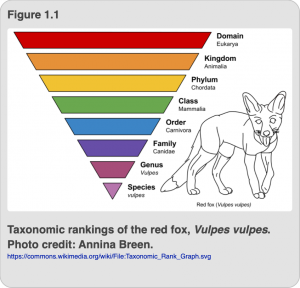
These taxonomic rankings provide each organism with a unique taxonomic address. This allows us to immediately understand some information about it much like we can infer information about people based on their own physical addresses. For example, if you learn that Dr. Megan Meuti is from the Midwestern United States, you can then fairly safely assume that she speaks English and enjoys eating cheese and fried food. Similarly, if you discover that the long-beaked echidna is a mammal, you would then know that it is likely furry and nurses its offspring, even if you had never heard of this creature before. To extend this metaphor a bit further, we must give our friends/family both our house number and street name if we want them to actually find us (i.e. I23 Shady Lane). Similarly, the most specific taxonomic designations, Genus and species, are always used together when referring to an organism (i.e. the species name of humans is Homo sapiens; the European honey bee is Apis mellifera). This use of binomial nomenclature, or referring to organisms by both their genus name (capitalized and italicized) and specific epithet or species name (written in lower case and italicized), is the hallmark of Carl Linneaus’ system and is still used by all scientists today.
And speaking of species, we should briefly consider what we mean by this. It turns out, it can be a lot more complicated than you originally anticipated! However, the idea of a species with which you are most familiar is probably the biological species definition which defines a species as a group of individuals that can breed with one another, but cannot breed/ produce fertile offspring with another group. While this makes intuitive sense and works well to define most higher-level plants and animals, it is somewhat limited. For example, what about organisms, such as bacteria, fungi and mosses, that reproduce asexually? Furthermore, how would you distinguish one extinct species from another? And what about organisms that can interbreed and produce fertile offspring (i.e. lions and tigers, which produce ligers and tygons), but rarely do so? To combat these problems, biologists have developed many other ways to distinguish different species based on their morphology, genetics, behavior, geographic distributions, and other characteristics, and they use these different species definitions when and where it is appropriate. However, the biological species definition is the one that works best to define relationships among insects and most other animals, and so we will stick with it!
Systematics
As most of you also learned in your high school biology classes, taxonomic groups represent a shared evolutionary history, such that species that belong to the same higher level taxon (Domain to Genus) are more closely related to one another than to species in a different taxon; therefore the taxonomic ranks should reflect a shared evolutionary history. This is the goal of systematics, which is the study of the diversification/evolution of extant (currently living) and extinct species, and the relationships among species, Genera, Families, Orders, Classes, Phyla, and Kingdoms (to use the plural forms of the words). The evolutionary relationships among different taxonomic groups are represented with phylogenetic trees (also known as phylogenies or cladograms) where the order of the branches reflects the relationships between the groups and where branch length shows the amount of evolutionary time and/or changes that have occurred between groups. For an example of a phylogenetic tree, please see Figure 1.2.
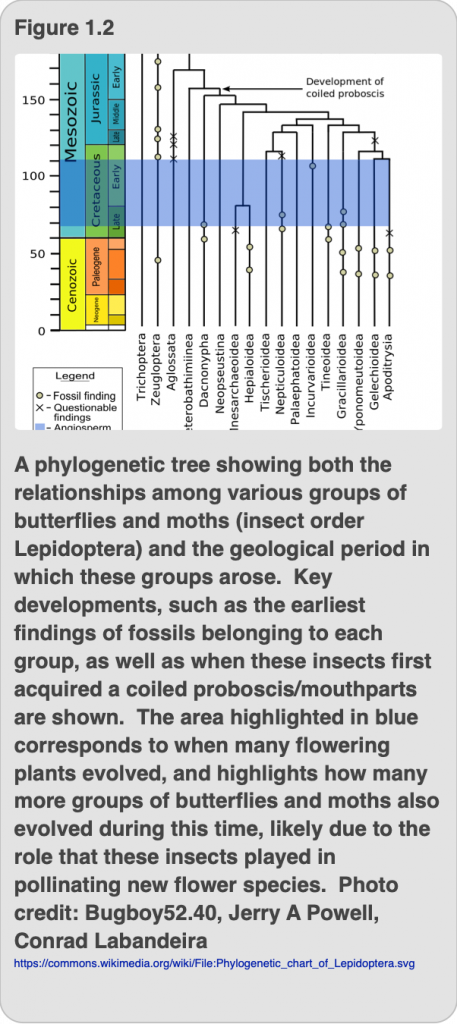
Challenges
One additional note regarding the benefits and limitations of taxonomy and systematics: we as humans love to categorize and characterize our surroundings into discrete boxes. This allows us to better organize the vast amount of information we perceive, and thereby better understand our world. Taxonomy and systematics is definitely a part of this effort, and is very useful, especially insofar as taxonomic relationships allow us to define similar characteristics among groups. However, we must keep in mind that living organisms, unlike nails and screws in a hardware store, cannot be easily binned and sorted. Indeed, as we just discussed, you can’t always necessarily get biologists to agree on how to define what a “species” is! This is in part because living organisms are much more complex than inanimate objects, but also because all forms of life are actively adapting and evolving to their environments. This means that sometimes two very closely related organisms might look, act, and behave very differently, perhaps in part, because they inhabit vastly different environments. For example, cows and manatees are very closely related, but look quite different from one another because cows live on land while manatees live in water. Conversely, sometimes two individuals might look and behave similarly because they inhabit similar environments even though they are very distantly related. For example, birds, bats, and insects all have wings, but these groups are very distantly related to one another, and they all developed wings independently of one another through a process known as convergent evolution.
To help resolve these issues, systematists (scientists that study the evolutionary relationships between organisms) are actively and constantly acquiring more information or data about individual and groups of organisms, and are testing hypotheses about the relationship of one taxon or group to another. As it turns out, we are just beginning to understand the remarkable amount of diversity on our planet. And in light of all of the new information, much of the taxonomy that we, the authors, were taught in college and even graduate school have since changed. In many other cases the groups and relationships are still unclear. Sadly, none of us are systematists, but we have attempted here to represent the best and most current understanding of the evolutionary relationships among different organisms.
Now, having learned a bit more about taxonomy and systematics generally, we will progress through the rest of the chapter by defining the different taxonomic levels to which insects and humans belong.
II. Domains
In 1977, Carl Woese, a pioneering biologist at the University of Illinois, made a remarkable discovery. Rather than discovering a new species or even a new Order of organisms, he discovered microbes that were so unlike anything else that an entirely new taxonomic rank, higher than the Kingdoms that had been recognized by biologists for centuries, had to be developed to accommodate them. This new group of organisms was placed into the Domain Archaea, suggesting their old or ancient origins. Initially, organisms belonging in Archaea were found in extreme environments, such as hot springs and salt lakes, but they have now been found virtually everywhere; from oceans to soils, and in our own mouths and colons, and new phyla of Archaea are being discovered every year.
The revolutionary findings of Woese completely changed the way that scientists view life on Earth. Prior to this time, cells were only classified as being either prokaryotic (lacking a nucleus) or eukaryotic (having a nucleus). Yet few people appreciated the incredible diversity of bacteria that surround us. Thanks to the advent of molecular biological techniques that allowed researchers to characterize microbes based on their genetic sequences rather than rearing them in the lab, we are now better able to study and appreciate the diversity of species in the Domain Bacteria. The relationships between Archaea and Bacteria are still being investigated, but at first glance they share many similarities. For example, both Archaea and Bacteria are prokaryotic, meaning that they lack a true nucleus and all of them are single-cellular. And although they can exchange small amounts of DNA with one another through the processes of transfection and horizontal gene transfer, all of them reproduce asexually such that the new daughter cell is an exact replicate or clone of the original cell. However, unlike bacterial species, archaeans use metabolic pathways that are more similar to the ones that our own cells use. Additionally, the cell membranes of archaeal species are composed of unique lipids or fats. And unlike single-cellular bacterial or eukaryotic species, there are no archaeal pathogens/parasites.
More amazing still, we are now realizing that the origins of our own domain, Domain Eukaryota, lay in the union between a large archaeal cell and a smaller symbiotic bacterial cell. This unique union occurred over 2,500 million years ago, and over a vast amount of evolutionary time the relationship between the host cell and the bacterial cell became tighter and tighter as each specialized on unique tasks. The internal bacterial cell devoted itself to producing energy, and eventually became the mitochondria that are present in just about every cell of every eukaryotic organism. Evidence of the bacterial origins of mitochondria can be found in the small amounts of their original genetic code that they have retained (mitochondrial DNA). Having outsourced its energy needs, the larger host cell was then able to develop a nucleus to enclose its genetic blueprint/DNA and increase in both size and complexity. Over time, these eukaryotic cells developed specific organelles, or sub-cellular structures, that were devoted to unique tasks such as detoxification (lysosomes), building and degrading fats and hormones (smooth endoplasmic reticulum), and protein packaging (Golgi apparatus). The development of a nucleus also led to another major evolutionary advance: sex! Eukaryotic organisms, generally having two sets of chromosomes, could create several unique gametes, or sex cells, that had various combinations of chromosomes from each set. These gametes, also known as sperm and egg cells, could then fuse with one another during fertilization yielding offspring that had unique combinations of characteristics from each of their parents. This process of sexual reproduction greatly increased the genetic diversity of eukaryotic organisms and is partly responsible for the current success and diversity of eukaryotic organisms. Additionally, the increase in cellular size and complexity afforded by having a nucleus and mitochondria allowed eukaryotic cells to come together to form larger and even more complex multicellular organisms. Indeed, no insects, humans, plants, or any of the other multicellular organisms that we know and love would have ever come to be had it not been for our humble archaeal and bacterial beginnings (Figure 1.3).
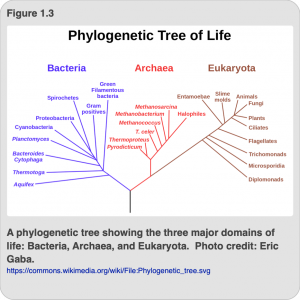
III. Kingdoms
While the use of DNA sequences to characterize and classify organisms has greatly enhanced our appreciation of the diversity of millions of microbial species that surround and abound within us, it has greatly complicated our understanding of the relationships among higher level taxa, especially among Kingdoms. As Figure 1.3 illustrates, the vast majority of the organisms on our planet are single-celled, including all members of Domain Bacteria and Domain Archaea. Even within Domain Eukaryota, there are several distinct lineages of single-cellular organisms which include things like ameobas, algae, and slime molds, as well as pathogenic organisms that cause malaria and African sleeping sickness. Previously, all of these single-cellular eukaryotic organisms were assigned to Kingdom Protista, which contained between 65,000 and 200,000 species. However, genetic evidence suggests that this group is polyphyletic, which means it has more than one common ancestor and hence is no longer taxonomically valid. How to define and classify each of these different groups of single- cellular, eukaryotic organisms is still being actively researched and debated among scientists. What is clear though is that three of the Kingdoms that you likely learned in your high school biology classes are monophyletic (all organisms within it descended from a single common ancestor) and hence are still valid: Kingdoms Fungi, Plantae, and Animalia.
Kingdom Fungi is unique among the other eukaryotic kingdoms in that it contains both single-cellular species, such as yeasts and molds that are responsible for making bread rise and fermenting alcohol, as well as multicellular species that form fruiting bodies, or mushrooms, when they reproduce. However, all fungi are characterized by having chitin in their cell wall, and being heterotrophic, meaning that they cannot produce their own food but acquire their nutrients and energy from other sources. Fungi can reproduce either asexually by budding, or sexually by recombining two sex cells that have a single set of chromosomes. Apart from their reproductive spores that travel through air or water, and in some species have cilia (short hairs) or flagella (long tails) as mechanisms for movement, fungi are sessile and do not move. Scientists estimate that there are between 1.5 to 5 million species of fungi, but that so far only ~5% of them have been described.
Kingdom Plantae includes all green plants, which are eukaryotic, multicellular, have cell walls that contain cellulose, and specialized organelles called chloroplasts that allow them to convert sunlight and carbon dioxide into sugars through the process of photosynthesis. Like mitochondria, these chloroplasts were also once free-living bacteria that eventually formed a tight symbiotic relationship with host plant cells, and still retain small amounts of their own DNA. The ability to harness the power of the sun to produce food means that plants are autotrophic, (auto= self; troph = feeding). Most plants reproduce sexually, although asexual reproduction is also common. So far, approximately 315,000 species of plants have been described, and the vast majority of these produce seeds. However, several ancient, non-seed producing plants exist including things like mosses, ferns, and liverworts. Like fungi, plants are also sessile, and rely on the wind, water, or animals to disperse their sex cells (gametes) through the process of pollination. Plants may also rely on wind, water, and animals to disperse their fruits and seeds.
The final kingdom we will discuss is the one with which you are most familiar, because it is the one to which both insects and we belong: Kingdom Animalia. All members of this kingdom are eukaryotic, multicellular, and heterotrophic. With the exception of the most primitive animals (sponges), all animals are motile or have the ability to move at some point in their lives, and most animal species reproduce sexually where offspring arise after the fusion of sperm and egg cells. Approximately 1,370,000 species of animals have been described so far, and of these 95% are invertebrates (lacking a backbone). That’s right friends, those friendly, furry charismatic critters that pop into your mind when you think of an “animal” really represent just a tiny portion of the species within our own kingdom, which in turn, represents only a tiny portion of the diversity within the Domain Eukaryota, which itself likely contains far fewer species than either Bacteria or Archaea. It is somewhat humbling to consider the tiny tip of the vast and diverse tree of life that humans and other mammals occupy.
IV. Phyla
Progressing on through the taxonomic ranks, we now come to the rank of Phylum. The number of phyla within Kingdom Animalia and the relationships among them are (surprise surprise) still being researched and debated among systematists, although there is a consensus that there are 36 animal phyla in total, with 9 major ones. Many of the morphological and developmental characteristics that biologists previously used to define and group animal phyla together are still valid and useful today, although evidence based on DNA sequences has shaken some things up (Figure 1.4).
Some of these characteristics include the presence and number of differentiated cell layers within the animal, the type of symmetry, and whether the mouth or anus forms first in a developing animal embryo. For example, the most primitive animals in Phylum Porifera (i.e. sponges) don’t have any differentiated cell layers or symmetry, while animals like jellyfish and sea anemones (Phylum Cnidaria) have radial symmetry and only two cell layers (an outer layer called the ectoderm and an inner called the endoderm). However, all of the other major animal phyla are characterized by having bilateral symmetry (the left sides and right sides are mirror images of one another) as well as having three cell layers: the ectoderm (skin or outer cell layer), endoderm (internal cell layer which becomes the gut), and the mesoderm (the middle cell layer which develops into muscle tissue). These three cell layers quickly arise in the developing embryos of all animals with bilateral symmetry.
This leads us to the next major division of phyla in the Animal Kingdom: protostomes (proto = first; stome = mouth) and deuterostomes (deuteron = second; stome = mouth). As you can see by breaking down their names and by looking at Figure 1.5, in protostomes the blastopore, or initial opening in the developing embryo, eventually becomes the mouth. In contrast, the blastopore eventually develops into the anus in deuterostomes. Although this might seem like an arbitrary difference, it leads to vastly different body plans and organ arrangements for these two different animal lineages. For example, the circulatory organs (i.e. the heart/ aorta) of protostomes such as insects and earthworms are located dorsally (along their backs) while their nervous system/ cord is located ventrally (along their stomachs). However, for deuterostomes such as starfish and vertebrates, it is just the opposite: our hearts are ventral and our nerve cords are dorsal.
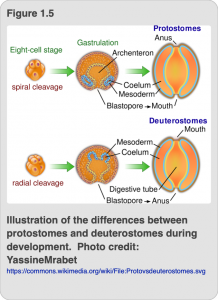
Phylum Arthropoda vs. Phylum Chordata
Although humans and insects belong to separate animal phyla, there are several characteristics that humans and insects share in addition to those of being animals (i.e. consisting of several eukaryotic cells, and being heterotrophic and motile). For example, both humans and insects have bilateral symmetry, three cell layers, and a body cavity. However, we will now also explore some of the differences between Phylum Arthropoda, which contains insects, and our own Phylum, Chordata.
Phylum Arthropoda
Once again, to get a sense of some of the complex biological words that we are throwing around, it is helpful to break them down into their etymological (not to be con- fused with “entomological”) roots. Thus “arthropod” literally means jointed (arthro = joint, as in arthritis) foot (pod = foot, as in podiatrist). Therefore all members of this phylum are characterized by having several jointed appendages that they use for walking/swimming and ingesting their food. Additionally, all arthropods have an exterior skeleton, called the exoskeleton, which is composed of chitin bound in a chemical complex with proteins. The strength/rigidity of the exoskeleton varies widely among arthropods and can be quite thick and hard, as in the case with king crabs, or quite thin and flexible, as seen with most caterpillars. However, as a consequence of this exoskeleton, any time an arthropod needs to grow or develop, it must shed and discard its former exoskeleton. Given these characteristics, you should now be able to recognize many of the major arthropod classes, such as arachnids, centipedes, millipedes, crustaceans, and (of course!) insects. We will briefly discuss these various arthropod classes in the sections below.
Another feature of arthropods is that their bodies are segmented, or divided into recognizable and discrete units. Because of this apparent segmentation, biologists initially believed that arthropods were most closely related to segmented worms (e.g. earthworms) in the Phylum Annelida. However, more recent molecular evidence suggests that arthropods are most closely related to roundworms in the Phylum Nematoda, which have no apparent segmentation, but do molt and shed their exoskeletons as they grow and develop. Other close relatives of arthropods include animals such as tardigrades, commonly known as water bears or moss piglets, and velvet worms (Figure 1.6 a, b).
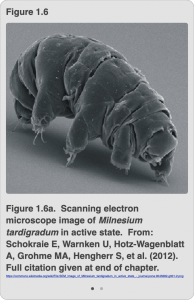
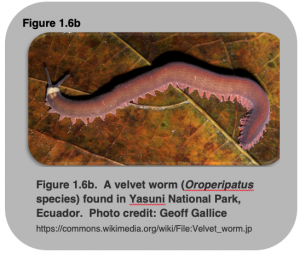

Of particular note is the vast diversity or number of arthropod species. Over one million species of insects alone have been described, and over 300,000 additional ar-thropod species have been cataloged, making Phylum Arthropoda far and away the most diverse of all of the animal phyla (Figure 1.7).
Phylum Chordata
Unlike arthropods, members of the Phylum Chordata have dorsal nerve tubes that are enclosed inside of a hollow sheath called a notochord (because they are deuterostomes). In the case of vertebrates, the dorsal nerve tube develops into the spinal cord and the notochord develops into the spine/vertebrae. Additionally, all chordate species have, at some point in their development, pharyngeal slits or gills, as well as a posterior tail. Some of the more ancient chordate groups that are not vertebrates include animals such as sea squirts and lancelets (Figure 1.8). There are 65,000 species of chordates, and of these over half of them are bony fishes.
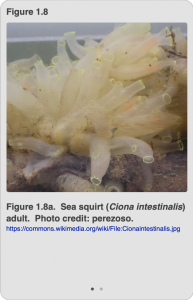
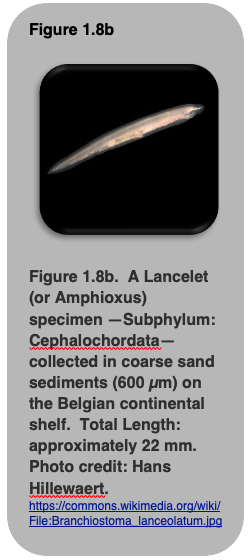
Chordates are most closely related to species in Phylum Echinodermata, which includes starfish and sea cucumbers, as well as Phylum Hemichordata, or acorn worms. Not to belabor the point of the differences between animal phyla, but we as entomologists are often frustrated when snails and slugs, which belong to the Phyum Mollusca, and earthworms, which belong to the Phylum Annelida, are often grouped with “bugs” or insects and other terrestrial arthropods. This is because a slug is taxonomically more different in comparison to an insect than humans are when compared to a starfish or an acorn worm.
V. Class
Continuing on down the taxonomic ladder, we now come to Class, and here again we will focus on some of the key classes within Phyla Arthropoda and Chordata, with a specific focus on Classes Insecta and Mammalia. We will also highlight the various other groups that are most closely related to our taxa of interest.
Different Arthropod Classes and Their Relationships
Class Arachnida
Members of this class include spiders, scorpions, and ticks. Arachnids are characterized by having chelicerate, or jaw-like mouthparts, two major body regions (the cephalathorax and the opisisthoma), and eight legs. All arachnids lack antennae, and all of them are also terrestrial. Currently over 100,000 species of arachnids have been described, but there are likely several tens to hundreds of thousands more that have yet to be identified. Most arachnids (including all spiders and scorpions) are predatory, feeding on other small arthropods or invertebrates. However, daddy long legs and harvestmen are primarily scavengers; and many species of mites will actively feed on plants, and others are external parasites such as the Varroa mite, which are parasites of honey bees. Ticks are a subgroup of mites, and all of them feed on vertebrate blood, such as the brown-legged tick, which transmits Lyme disease to rodents, deer, dogs, and humans.
The rest of this book will focus primarily on insects, but from time to time we will refer to members of other arthropod groups, particularly arachnids. Although members of Class Arachnida are most distantly related to insects (Figure 1.9), since all insects are also terrestrial, they have many shared characteristics with arachnids.
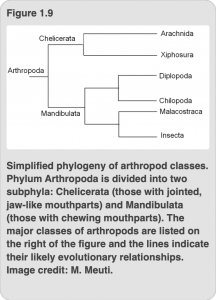
Moreover, spiders and other arachnids are key predators and parasites of insects. They are also capable of eliciting great fear in many people (hence arachnophobia). Additionally, mites and ticks play important roles as vectors/transmitters of human and plant diseases, and researchers are investigating the potential of using venom from scorpions and spiders to target and treat cancer cells (Chapter 22). Hence, you will be learning a lot more about arachnids as you progress through this book!
Classes Diplopoda and Chilopoda
Classes Diplopoda (millipedes) and Chilopoda (centipedes) are morphologically similar; members of both of these classes have a head with mandibulate/chewing mouthparts and antennae, and a long trunk containing a dizzying number of legs (approximately 30-354 legs for centipedes, and up to 780 legs on a millipede). Yet the relationship between these two classes, as well as their relationships to other groups of arthropods remains unclear.
There are ~12,000 species described in Class Diplopoda. As their name might suggest, they have two pairs of legs (di = two; pod = feet) on each body segment, and one unique feature of most millipedes is that their legs come out from the base of the body. This allows millipedes to curl up into a ball as a defensive measure when they are threatened by predators, but also greatly limits how quickly they can move (much like a lady walking in a tight mini-skirt). However, as nearly all millipedes are detritivores (i.e. consume detritus or rotting plant material) they don’t need to move very quickly. Therefore, if you see a slow-moving arthropod with lots of legs crawling around some wet leaves or rotting fruit, it is likely a millipede and you have nothing to fear.
Species in Class Chilopoda (meaning “claw feet”), in contrast, are quite fearsome indeed. All of the 3,000 described species are predatory. Also, unlike millipedes, centipedes have one pair of legs on each body segment that come out at the sides of their bodies, allowing them to run very quickly. More frightening still, and as their name implies, the first pair of legs on every centipede’s body have been modified to be hollow and sharp, essentially functioning like the fangs of a spider. A venom gland is present at the base of these modified legs, allowing centipedes to deliver a painful and toxic bite to their prey. Indeed, some species of centipedes that inhabit the tropics hunt down mice and snakes, and can deliver a potentially lethal bite to people, or even leave blisters on every spot where their feet touch human skin. Fortunately, most species of centipedes in the U.S. are not very dangerous, as their fangs are not capable of piercing our thick skin and their venom is not particularly potent. Nonetheless, if you spot a fast moving arthropod with lots of legs crawling around the ground or your basement, it is best not to pick it up with your bare hands. Please note that members of the classes Arachnida, Chilopoda, and Diplopoda will be featured prominently in Chapter 21, which covers insect defensive compounds.
Class Malacostraca
This class contains about 40,000 different species and includes the arthropods that people in the U.S. most like to eat, including crabs, shrimp, and lobsters. You might also be surprised to learn that the rollie pollies (pill bugs) or potato bugs that many of you likely played with as kids also belong to this Class. Class Malocostraca belongs to the larger group of crustaceans (sometimes ranked as a subphylum), including sea monkeys or brine shrimp (Class Branchiopoda), as well as cocopods and barnacles (Class Maxillopoda). Like all other crustaceans, malacostracans have paired limbs and two pairs of antennae. What is unique about members of Malocostraca, however, is that they have three distinct body regions: a head composed of five body segments, a thorax composed of eight segments, and a six- segmented abdomen that bears appendages.
Recent molecular evidence suggests that the crustaceans are likely polyphyletic, or have descended from multiple different ancestors. Therefore, some crustaceans in Class Malocostraca are more closely-related to insects than they are to some other crustaceans. Hopefully as researchers are able to study more arthropod species and genetic sequences, the relationships among the various classes of arthropods will become more clear.
Class Insecta
Members of this class of arthropods include all of the insects that we know, love, and sometimes loathe, including dragonflies, grasshoppers, stink bugs, beetles, butterflies, mosquitoes, bees and wasps. Like other mandibulate arthropods, insects have antennae, and most species have retained their ancestral chewing mouthparts. And similar to members of the Class Malocostraca, all insects have three body regions: the head, thorax, and abdomen. However, unlike crabs and lobsters, insects have three pairs of appendages (six legs total) and they are all on the thorax rather than the abdomen.
Another unique adaptation that occurred relatively early in insect evolution was the development of wings; although there are several groups of primitively wingless insects like silverfish and jumping bristletails, as well as non-insect hexapods (six legged critters that are closely-related to insects) such as springtails. How, precisely, wings evolved in insects is still unclear, for unlike other winged animals (e.g. birds and bats), the wings of insects are extra appendages and not just modified legs. Some scientists have proposed that wings evolved from novel outgrowths or extensions on the insect thorax, while others believe that they evolved from gills in aquatic insects, and there is mounting evidence that this might very well be the case. What is clear, however, is that acquiring the ability to fly greatly enhanced the success of insects, allowing them to colonize and inhabit new environments. This might explain the overwhelming diversity of insect species: over one million species of insects have been described, and some estimate that there may be as many as ten million other insect species that have not been identified. This makes Class Insecta far and away the most diverse Class of animals.
Different Chordate Classes and Their Relationships
Although there are far fewer chordate species (68,000 in the entire phylum) there is still a remarkable amount diversity, especially within Subphylum Vertebrata (the vertebrates) with which we are all most familiar. By examining Figure 1.10, you will immediately notice many of the major and familiar classes of vertebrates. These include cartilaginous fishes, such as sharks and sting rays belonging to Class Chondrichthyes, containing ~640 species. Also bony fishes belonging to Class Osteichthyes, containing ~28,000 species (the most diverse class of all Chordates). The three most recent vertebrate classes to evolve are all tetrapods, meaning that they have four limbs. These are amphibians belonging to Class Amphibia, containing ~7,000 species; reptiles and birds belonging to Class Sauropsida which contains ~20,000 species; and our own class, Mammalia.
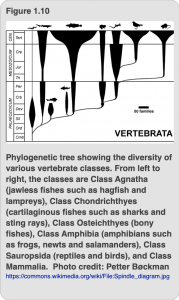
Class Sauropsida
Many of you might be surprised to have discovered that birds are now grouped with reptiles in Class Sauropsida. After all, birds seem fairly distinct from lizards, turtles, and snakes in that birds are covered with feathers and are endothermic (able to produce their own body heat). Additionally, the forelimbs in birds have been modified into wings. Given all of these unique characteristics, it is not surprising that historically birds were placed in their own class (Class Aves). Yet once again, recent molecular evidence lead to a taxonomic change when it became apparent that birds share a common ancestor with all other reptile groups. Hence, the previously recognized Class Reptilia, which included snake, lizard, turtle, and crocodile lineages, but not birds (even though they descended from the same common ancestor) was paraphyletic. To resolve this issue, scientists now recognize the monophyletic Class Sauropsida, which includes all of the descendants of a single common ancestor (Figure 1.11).
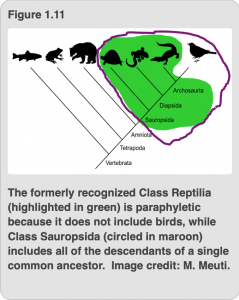
Class Mammalia
Mammals are unique among other four legged vertebrates (tetrapods) in that our bodies are covered with fur or hair instead of scales or feathers, our middle ears contain three bones, and we have a region of our brain called the neocortex or forebrain. Like birds, mammals are endothermic, meaning that we generate our own body heat and maintain a constant temperature, although this feature evolved independently in birds and mammals. The most notable feature that all mammals share is that we provide milk to our young. In fact, out Class was named for this special feature, or the mammary glands in female mammals. Most mammals incubate their offspring internally, although some primitive mammals, such as the Duck-Billed platypus and the Long Beaked Echidna (mentioned earlier in the chapter), lay eggs and then nurse/feed their offspring after they hatch. And marsupials such as kangaroos, opossums, and koala bear young develop in a specialized pouch rather than inside of their mother’s uterus.
VI. Order
Moving on down the taxonomic ladder, we now come to the rank of Order. Depending on the systematist, there are between 24 and 26 different orders of insects and 19 mammalian orders. Rather than explore or describe each of these in any detail, we instead will focus on a handful of key orders in each group. The insect orders that we will describe here will be later featured in the book, while the mammalian orders that we will discuss here will help give you a better sense of the diversity within our own class as well as the relationship between humans and other mammals.
Key Insect Orders
The exact number and relationships of insect orders are still being investigated (notice a common theme yet?), but generally there is a consensus (finally) about the relationship of some of the major groupings. The sequence in which we discuss the various orders listed here is representative of their phylogeny and evolutionary history, starting with the more ancient insects and progressing to more recently evolved groups.
Order Odonata
Meaning: Toothed ones (don = tooth as in orthodontist)
Common names: Dragonflies and damselflies
Number of species: ~5,000
Evolutionary history: Earliest fossils ~350 million years ago
Common characteristics: Both the immature and adult forms are voracious predators. The nymphs/immatures of these insects are aquatic, feeding on other small arthropods and sometimes fish and tadpoles that live at the bottom of ponds, streams, and rivers. The adults are excellent flyers capable of catching their prey on the wing, and even mating in flight (Chapter 6). The adults have short antennae, chewing mouthparts, and clear wings with many cross veins.
Order Orthoptera
Meaning: Straight wing (ortho = straight as in orthodontist; ptera = wing, like Ptero- dactyl)
Common names: Grasshoppers, katydids, and crickets
Number of species: >20,000
Evolutionary history: ~350 million years ago
Common characteristics: Members of this group are all either herbivorous (feeding on plants), or are scavengers. They are also known for their unique courtship, where males will sing to attract females (further discussed in Chapter 9). As their name implies, they fold their wings straight along their backs, and are characterized by having hindlegs that are modified for jumping. Indeed, the best way to remember this order is that “hop” is right in the name Orthoptera!
Order Hemiptera
Meaning: Half wing (hemi = half; ptera = wing)
Common names: True bugs, cicadas, aphids, white flies, and scale insects
Number of species: >50,000
Evolutionary history: 325 million years ago
Common characteristics: Members of this group are all characterized by having modified mouthparts that form a tube for piercing and sucking liquids. Most members of this group feed on plant juices and can be serious pests (e.g. aphids and stink bugs), although there are several predatory species and a few that feed on vertebrate blood, such as bed bugs and kissing bugs.
Order Coleoptera
Meaning: Shield wing (coleo = shield; ptera = wing)
Common names: Beetles and weevils
Number of species: >350,000
Evolutionary history: 280 million years ago
Common characteristics: As their Latin name implies, the most unique and defining characteristic of beetles is that their forewings have formed into hardened shells called elytra which cover and protect the thin and clear hindwings. This means that beetles are not particularly good fliers, but they are perhaps the most successful group of all of the insects. Beetles undergo complete metamorphosis, where the immature larvae look nothing like the adult beetles. All beetles also have chewing mouthparts, which they may use to devour plants, wood, other small arthropods, and even poop or carrion (rotting vertebrate flesh). When asked what could be learned about the Creator from studying creation, the famous evolutionary biologist J.B. Haldane proclaimed that “He has an inordinate fondness for beetles,” simply because there are so very many of them.
Order Lepidoptera
Meaning: Scale wings (lep = scale as in leprosy; ptera = wing)
Common names: Butterflies, moths, and skippers
Number of species: ~160,000
Evolutionary history: ~240 million years ago
Common characteristics: Adult members of this insect order are characterized by having flattened hairs (called scales) that cover their forewings and hindwings, which are often beautifully and brightly colored. It is the beauty of these adults that have captured human imagination for centuries, and partly why they are frequently featured in myths. Like beetles, members of this order undergo complete metamorphosis where the larval caterpillars later transform into adults butterflies and moths. The caterpillars all have chewing mouthparts and almost all of them feed exclusively on plants. The adults generally have long, coiled mouthparts that form a proboscis which they use to feed on nectar or fruit. However, several adult butterflies and moths might not have any mouthparts at all and therefore only live for a short time.
Order Diptera
Meaning: Two wings (di = two; ptera = wing)
Common name: Mosquitoes, midges, and true flies
Number of species: >150,000
Evolutionary history: 175 million years ago
Common characteristics: Again, the Latin names are most helpful: the defining characteristic of adult insects in this order is that they have two easily recognizable wings, while the hindwings have been modified into club-like organs called halteres. This allows dipterans to be exceptionally good fliers, accomplishing such feats as being able to turn on much less than a dime, hover in midair for extended periods of time, and even fly backwards. Similar to beetles and butterflies, flies also undergo complete metamorphosis and the larval forms of many of these are affectionately known as maggots. The mouthparts of the maggots and adult flies are variously modified depending on what they consume, although common food sources include carrion (rotting vertebrate flesh), poop, nectar or pollen, other arthropods, and vertebrate blood. Many species (e.g. several mosquito species) transmit deadly diseases to humans and other vertebrates, and generally flies have not been highly regarded in human myths and religions.
Order Hymenoptera
Meaning: Married wing (Hymen = Greek god of marriage; ptera = wing)
Common name: Sawflies, wasps, bees, and ants
Number of species: ~150,000
Evolutionary history: 265 million years ago
Common characteristics: Adult hymenopterans have a row of hooks on their hindwings which allow it to attach to the forewing, thus contributing to their Latin name (married-wing) and also making them excellent and efficient fliers. Other unique features of this group are that there is generally a narrow constriction or “waist” between the thorax and the abdomen. Adult hymenopterans generally feed on nectar and pollen, and are vital pollinators, although several species are predatory. Many species of adult females in this group also have stingers derived from modified ovipositors, the structure that they use to lay eggs. These modified ovipositors can be used to deliver venom to would-be predators or their prey. Like the previous three insect orders we discussed, hymenopterans undergo complete metamorphosis, and within this order the larvae are often cared for by either their mothers or sisters. Several hymenopteran species are social, meaning that they live together in colonies of closely related individuals, work together to take care of the babies, and in the most social societies, reproduction is limited to one or a few “queens.” This includes insects like ants, yellow jackets, and honey bees. Additionally, thousands of species of hymenopterans are parasitoids of other insects, where a female will lay her eggs into a host and the larvae will hatch out and devour the poor insect from the inside out. (Can you imagine a more gruesome way to die?)
Key Mammalian Orders
Order Monotremata
Meaning: Single hole (mono =one/single as in monogamy; trema = hole)
Common names: Platypus and echidna
Number of species: 5
Evolutionary history: ~225 million years ago
Common characteristics: Monotremes are the most ancient of all mammals and have retained the egg-laying characteristics of the reptiles that were the most recent common ancestors. However, like all other mammals, their bodies are covered with fur, they have three bones in their middle ear, and females produce milk to nourish their young.
Order Carnivora
Meaning: Flesh eaters
Common names: Dogs, cats, bears, weasels, hyenas, raccoons, wolverines, and walruses
Number of species: >280
Evolutionary history: ~42 million years ago
Common characteristics: Like other placental mammals, members of this order undergo internal embryonic development. Carnivores generally have teeth and claws that are well-adapted to capturing and eating other vertebrates. Many feed exclusively on meat/vertebrate flesh while others, such as bears and raccoons, will also eat eggs, berries and insects/ invertebrates, and the giant panda feeds exclusively on bamboo.
Order Rodentia
Meaning: Gnawers
Common names: Rats, mice, squirrels, beavers, prairie dogs, and porcupines
Number of species: ~1,500
Evolutionary history: 66 million years ago
Common characteristics: Most rodents are relatively small mammals with four short legs and long tails, but the most defining characteristic of this group are their constantly growing incisor teeth in both their upper and lower jaws. Because these teeth never stop growing, rodents must constantly wear them down, otherwise they will pierce through the skull. Because older rodents aren’t able to grind down their teeth as well, we have the expression that a person who is “long in the tooth” is older. Rodents generally have an excellent sense of smell and hearing, and many species are nocturnal. Believe it or not, outside of our own order (Primates) rodents are our next closest relatives, which is why mice and rats are commonly used in biomedical research; we still share many of the same underlying characteristics.
Order Primates
Meaning: First rank
Common names: Lemurs, monkeys, and apes
Number of species: 446
Evolutionary history: ~56 million years ago
Common characteristics: Primates have larger brains in proportion to their body size, relative to other mammals, and have an increased reliance on vision but are less perceptive to smell. Indeed, in some primates (including us) have developed three-color vision while most other mammals see only in black and white. Primates also take longer to reach developmental maturity, but generally enjoy longer lifespans than other, similarly-sized mammals. Additionally, most primates are social and live in large groups with complex relationships among other members of the group. Apart from humans, which live on every continent on Earth, most primates are arboreal (live in trees) in tropical and sub-tropical environments.
VII. Family, Genus, & Species
The final three taxonomic ranks (Family, Genus, and species) are the most refined levels or, to extend our earlier metaphor, the final components of the taxonomic addresses. Given the incredible diversity of insects, you might not be surprised to discover that there are well over 500 families of insects, some containing only a single genus and/or species, while others contain tens of thousands of unique species. Although mammals are also quite diverse, once again the numbers pale in comparison: there are 153 families of mammals that are separated into to 1,229 genera. Given these daunting numbers, we will not provide extensive examples of these final taxonomic levels for multiple insect and mammal species. Instead, we will review the entire taxonomic addresses for a representative insect species (the European honey bee) and a representative mammal (a human).
As many of you are already aware, honey bees are vital pollinators of several important agricultural crops, and they produce a delicious natural sweetener (honey) in the process. Additionally, honey bees live in large, complex societies and are the only other species, apart from humans, to have a symbolic language; they are able to communicate the location, quality, and quantity of nectar sources through dance. Indeed, honey bees are truly remarkable insects, and there are seven species all of which belong to the genus Apis. Because taxonomists are a little Type A, each family name is based on one genus name within the family (called the type genus). Fortuitously for us, Apis is the representative (type genus) for all of the ~5,700 species of bees belonging to Family Apidae. The species that is most commonly cultivated in the U.S. originated from Europe and hence has the official common name of “European honey bee”, and the species name of Apis mellifera. Therefore, you now have all of the information that you need to classify the European honey bee, from Domain to species.
Concerning humans, our species name is Homo sapiens, meaning “wise man.” Moreover, the genus Homo is also the type genus of our own taxonomic family, Hominidae. This family includes six other living species belonging to three other genera: Pongo, containing two species of orangutans; Gorilla, containing two species of gorillas; and Pan which contains the common chimpanzee and the bonobo. These other great apes represent our closest living relatives, although our last shared a common ancestor lived approximately 5-7 million years ago. Once again, you have all of the information to classify humans all the way from Domain to species. In doing so, we hope that you get a sense of where insects and humans fit in the incredible array of diversity of life forms on our amazing planet.
VIII. Chapter Summary
We sincerely hope that you have enjoyed learning more about both taxonomy and systematics, and that you now have a better sense of various groups of insects and how insects are similar to and different from other arthropods and invertebrates. Likewise, we hope that you are able to compare and contrast the similarities and differences between insects and humans, as well as humans and other chordates and mammals.
Below is a list of terms which help better define the similarities between insects and humans. We recommend that you review these terms and truly flesh out these differences. After doing this, we also encourage you to generate a list of the similarities and differences between insects and other arthropods, as well as humans and other chordates.
Shared Characteristics Between Insects and Humans
1.) Eukaryotic
2.) Heterotrophic
3.) Multicellular
4.) Bilateral symmetry
Anything else?
Differences Between Insects and Humans
1.) Protostomes vs. deuterostomes
2.) Type of skeleton
3.) Number of body regions
4.) Number of legs Anything else?
References
Chapter 1 Cover Photo: Tree of Life. CC0 Public Domain, PublicDomainPictures. Ac- cessed via pixabay.com
Figure 1.1: Taxonomic rankings of the red fox, Vulpes vulpes. CC-BY-SA 4.0: Annina Breen. Accessed via https://commons.wikimedia.org/wiki/File:Taxonomic_Rank_Graph.svg
Figure 1.2: Lepidoptera phylogenetic tree. CC-BY-SA 3.0: Bugboy52.40, Jerry A Powell, Conrad Labandeira. Accessed via https://commons.wikimedia.org/wiki/File:Phylogenetic_chart_of_Lepidoptera.svg
Figure 1.3: Phylogenetic tree. Public Domain: Eric Gaba. Accessed via https://commons.wikimedia.org/wiki/File:Phylogenetic_tree.svg
Figure 1.4: Animal kingdom phylogenetic tree. Available at
http://wiki.hicksvilleschools.org/groups/hsbiology/wiki/18f5d/Comparative_Anatomy_Project.html
Figure 1.5: Protostomes vs. Deuterostomes. CC-BY-SA 3.0: YassineMrabet. Accessed via https://commons.wikimedia.org/wiki/File:Protovsdeuterostomes.svg
Figure 1.6a: SEM image of Milnesium tardigradum in active state. CC-BY 2.5: Schokraie E, Warnken U, Hotz-Wagenblatt A, Grohme MA, Hengherr S, et al. (2012) Comparative pro- teome analysis of Milnesium tardigradum in early embryonic state versus adults in active and anhydrobiotic state. PLoS ONE 7(9): e45682. doi:10.1371/journal.pone.0045682. Ac- cessed via
https://commons.wikimedia.org/wiki/File:SEM_image_of_Milnesium_tardigradum_in_active_state_-_journal.pone.0045682.g001-2.png
Figure 1.6b: An Oroperipatus species found in Yasuni National Park, Ecuador. CC-BY 2.0: Geoff Gallice. Accessed via https://commons.wikimedia.org/wiki/File:Velvet_worm.jpg
Figure 1.7: Pie chart of described animal species. Public Domain: Nick Beason. Ac- cessed via https://commons.wikimedia.org/wiki/File:AnimalsRelativeNumbers.png
Figure 1.8a: Ciona intestinalis adult. CC-BY-SA 3.0: perezoso. Accessed via https://commons.wikimedia.org/wiki/File:Cionaintestinalis.jpg
Figure 1.8b: Lancelet. CC-BY-SA 4.0: Hans Hillewaert. Accessed via https://commons.wikimedia.org/wiki/File:Branchiostoma_lanceolatum.jpg
Figure 1.9: Simplified arthropod phylogeny. M. Meuti (own work)
Figure 1.10: Vertebrate phylogenetic tree. Public Domain: Petter Bøckman. Accessed via https://commons.wikimedia.org/wiki/File:Spindle_diagram.jpg
Figure 1.11: Phylogeny showing Class Sauropsida. M. Meuti (own work).
Interactive Diagram 1.1: Selected Phyla, Classes, and Orders within the Animal Kingdom.
W. S. Klooster (own work)
Additional Readings
Averoff, M. and Cohen S. M. 1997. Evolutionary origin of insect wings from ancestral gills. Nature 385: 637-30. https://www.ncbi.nlm.nih.gov/pubmed/9024659
Lane, N., 2006. Power, sex, suicide: mitochondria and the meaning of life. Oxford Univer- sity Press.
Modesto, S.P. and Anderson, J.S., 2004. The phylogenetic definition of Reptilia. Systematic biology, 53: 815-821.
Regier, J.C., Shultz, J.W., Zwick, A., Hussey, A., Ball, B., Wetzer, R., Martin, J.W. and Cun- ningham, C.W., 2010. Arthropod relationships revealed by phylogenomic analysis of nu- clear protein-coding sequences. Nature, 463: 1079-1083.
Young, Ed. 2016. I contain multitudes: The microbes within us and a grander view of life. Harper press. New York, New York.